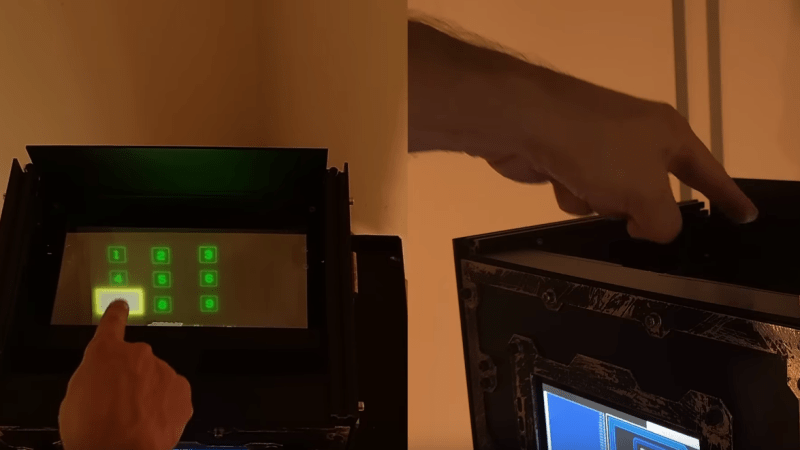If there’s a reason that fancy holographic displays that respond to gestures are a science fiction staple, it’s probably because our current display technology is terrible. Oh sure, Retina displays and big curved gaming monitors are things of wonder, but they’re also things that occupy space even when they’re off — hence the yearning for a display that can appear and disappear at need.
Now, we’re not sure if [Maker Mac70]’s floating display is the answer to your sci-fi dreams, but it’s still pretty cool. And, as with the best of tricks, it’s all done with mirrors. The idea is to use a combination of a partially reflective mirror, a sheet of retroreflective material, and a bright LCD panel. These are set up in an equilateral triangle arrangement, with the partially reflective mirror at the top. Part of the light from the LCD bounces off the bottom surface of the mirror onto a retroreflector — [Mac] used a sheet of material similar to what’s used on traffic signs. True to its name, the retroreflector bounces the light directly back at the semi-transparent mirror, passing through it to focus on a point in space above the whole contraption. To make the display interactive, [Mac] used a trio of cheap time-of-flight (TOF) sensors to watch for fingers poking into the space into which the display is projected. It seemed to work well enough after some tweaking; you can check it out in the video below, which also has some great tips on greebling, if that’s your thing.
We suspect that the thumbnail for the video is a composite, but that’s understandable since the conditions for viewing such a display have to be just right in terms of ambient light level and the viewer’s position relative to the display. [Mac] even mentions the narrow acceptance angle of the display, touting it as a potential benefit for use cases where privacy is a concern. In any case, it’s very different from his last sci-fi-inspired volumetric display, which was pretty cool too.















That isn’t an equilateral triangle. It’s a right triangle.
Replace the standard flat LCD with a lightfield display, and et voila! A free-air pseudovolumetric display! From within the eyebox (which will be the same as for the flat panel) the image will be focusable at different depths, and motion within the eyebox will be parallax-correct without head-tracking – which means images will shift correctly under vergence, which is not the case for a 2D tracked stereoscopic display.
For those getting existed and thinking they can just slap a Looking Glass display in the same spot: unfortunately, whilst they bill themselves as selling lightfield displays, they’re just autostereo displays so you only get multiple views along a single axis (horizontal).
“If there’s a reason that fancy holographic displays that respond to gestures are a science fiction staple, it’s probably because our current display technology is terrible”
Well, it’s because our current display technology is designed for the viewer, not for a third-party camera viewpoint. Even “real” computers in movies will have a projector shining the image back at the user’s face – good for visual storytelling, but not something you’d want to retrofit on your Dell.
There’s actually a very interesting Marshall Mcluhan-type conversation here about why movies are stumped by computers, and especially by smartphones. The only honest way to frame someone using a screen is to put them /behind/ the camera; cinema breaks down at a conceptual level in trying to represent people interacting online.
Kind-of? If you’re willing to ditch versimilitude of the “real world” trying to capture computer by photographing the screen being used and instead go for a versimilitude of the virtual world and capture the screen as if it exists on it’s own it works pretty decent. See the technique Sherlock used for texts and a LOT of anime use where they just show a chat conversation or even NND-style on-video comments. So maybe filmmakers are just doing it badly and not taking feedback. Which is par-for-the-course with how they also seem to ignore television production cost-limiting techniques.